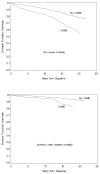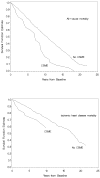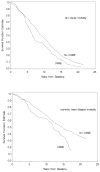Clinically significant macular edema and survival in type 1 and type 2 diabetes
- PMID: 18226797
- PMCID: PMC2440953
- DOI: 10.1016/j.ajo.2007.11.019
Clinically significant macular edema and survival in type 1 and type 2 diabetes
Abstract
Purpose: To investigate the association of clinically significant macular edema (CSME) and long-term survival in individuals with type 1 and type 2 diabetes.
Design: Population-based cohort study.
Methods: The Wisconsin Epidemiologic Study of Diabetic Retinopathy (WESDR) is an ongoing prospective population-based cohort study initiated from August 21, 1980 through July 30, 1982 of individuals with diabetes diagnosed at either younger than 30 years of age (younger-onset group; n = 996) or 30 years of age or older (older-onset group; n = 1,370). Stereoscopic color retinal photographs were graded for retinopathy using the modified Airlie House classification scheme. CSME was defined by the Early Treatment Diabetic Retinopathy Study criteria.
Results: Prevalence of CSME was 5.9% and 7.5% for the younger- and older-onset groups, respectively. After 20 years of follow-up, 276 younger-onset and 1,197 older-onset persons died. When adjusting for age and gender, CSME was not significantly associated with all-cause mortality (hazard ratio [HR], 1.41; 95% confidence interval [CI], 0.96 to 2.07; P = .08) or ischemic heart disease mortality (HR, 1.14; 95% CI, 0.61 to 2.12; P = .68) in the younger-onset group. In the older-onset group, there was increased all-cause and ischemic heart disease mortality when CSME was present (HR, 1.55; 95% CI, 1.25 to 1.92; P < .01; and HR, 1.56; 95% CI, 1.15 to 2.13; P < .01, respectively), when adjusting for age and gender. After controlling for other risk factors, the association remained significant for ischemic heart disease (HR, 1.58; 95% CI, 1.07 to 2.35; P = .02) among those taking insulin. CSME was not significantly associated with stroke mortality in either group.
Conclusions: CSME seems to be a risk indicator for decreased survival in persons with older-onset diabetes mellitus. The presence of CSME may identify individuals who should be receiving care for detection and treatment of cardiovascular disease.
Figures



References
-
- Juutilainen A, Lehto S, Ronnemaa T, Pyorala K, Laakso M. Retinopathy predicts cardiovascular mortality in type 2 diabetic men and women. Diabetes Care. 2007;30:292–299. - PubMed
-
- Klein R, Klein BE, Moss SE, Cruickshanks KJ. Association of ocular disease and mortality in a diabetic population. Arch Ophthalmol. 1999;117:1487–1495. - PubMed
-
- Klein R, Moss SE, Klein BE, DeMets DL. Relation of ocular and systemic factors to survival in diabetes. Arch Intern Med. 1989;149:266–272. - PubMed
-
- van Hecke MV, Dekker JM, Nijpels G, et al. Retinopathy is associated with cardiovascular and all-cause mortality in both diabetic and nondiabetic subjects: the hoorn study. Diabetes Care. 2003;26:2958. - PubMed
-
- Cusick M, Meleth AD, Agron E, et al. Associations of mortality and diabetes complications in patients with type 1 and type 2 diabetes: early treatment diabetic retinopathy study report no. 27 Diabetes Care. 2005;28:617–625. - PubMed
Publication types
MeSH terms
Grants and funding
LinkOut - more resources
Full Text Sources
Medical

